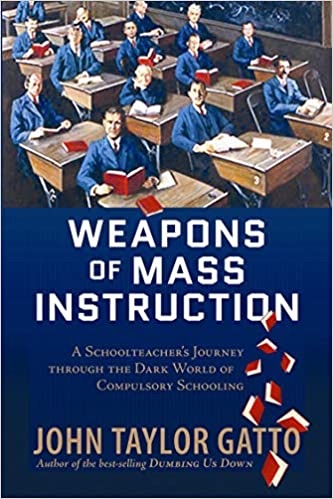
Weapons of Mass Instruction: A Schoolteacher’s Journey Through the Dark World of Compulsory Schooling by John Taylor Gatto explains how the “Germain” system of schooling adopted in the US was designed to produce docile factory workers and not original thinkers. As you read this important book reflect on how your schooling and the current schools in your community use the weapons of mass instruction John describes.
Prologue: Against School
- John’s experience shows that the main theme in secondary schools in the US is boredom. This can be traced back to our school’s Prussian heritage which offered a design aimed at producing mediocre intellects that would ensure a population composed mostly of docile and incomplete citizens. In other words, a manageable population. This type of schooling precludes critical thinking and strives to make children compliant and as alike as possible. At some point, they get sorted into manual labor and college tracks. The unfit are tagged with bad grades, remedial placements, and other punishments.
- Not only are students designed to engage in mass production, it’s vital that they also engage in mass consumption of things they may not need. They are sitting ducks for the folks in marketing. The good news is that once you discover the tricks and traps of modern schooling, they are easy to avoid. This book promises to help you do just that.
1. Everything You Know About School is Wrong
- This chapter focuses on the history of American schools. Prior to the school for all movement of the mid 19th century, children were included in family work, thinking, and inventing. Education was open-sourced and goals included self-reliance, ingenuity, courage, competence, and other frontier virtues. As students in factory schools, they became consumers of facts rather than producers of anything. While original thinking was patronized at times, it was subtly discouraged. There was also the beginning of the shift from local control to federal influence as school districts became larger, more bureaucratic, and less efficient.
2. Walkabout: London
- Here we are introduced to the concept of open-source learning. This is the learning that happens outside of schools when individuals decide for themselves what they want to learn and who they want to learn it from. This chapter tells the stories of many people who became very successful without college degrees. Some dropped out of college. Some never spent a day in college, and some are even high school dropouts. It seems that for many passionate and driven people, school as we know it only gets in the way.
- In the US 1.25 million students drop out each year. This takes courage and we should help these kids learn what they want to learn rather than giving up on them. Many students who do go to college end up learning little or nothing and end up with a huge debt and a grim career outlook. Perhaps more students should intentionally take up open-source learning rather than going to college. While John went to two Ivy League schools, he finds that most of what he learned that mattered happened outside of school. He also revisits the role schools play in standardizing students so they can serve corporate needs.
3. Fat Stanley and the Lancaster Amish
- Stanley was one of John’s students with an attendance problem. What John discovered was that he was skipping school to in turn work for free for five relatives who had their own businesses. He wanted to learn how to run a business so he could be running his own by the time he was 21. Once John knew this he started reporting Stanly as present as he knew that Stanley was learning more than John could teach him in school.
- We then look at the Amish with a focus on their values. While they never attend high school, they are successful entrepreneurs. They are innovative, take risks, have a strong work ethic, have high standards of craftsmanship, and use their families as their labor force. They are also legendary good neighbors. Amish children all experience practical internships and apprenticeships supervised by adults. In a sense, Stanley had discovered the secret of the Amish and adopted it for himself.
4. David Sarnott’s Classroom
- David Sarnoff arrived from Russia at the age of nine. His father promptly died and he taught himself English and got a job selling newspapers to be the family breadwinner. In five months he was fluent with no school. At fourteen he had his own newsstand. When he saw an ad for an office boy at Marconi Wireless he crashed a line of 500 boys and got the job. The lesson here is that waiting your turn is often the worst way to get what you want. As an office boy, he taught himself telegraphy and soon found himself on the leading edge of technology. At the age of 39, he became president of the Company then called RCA. He did all this without one day of school.
- John believes that if we taught kids to think critically and express themselves effectively that they wouldn’t put up with the nonsense schools force down their throats. Borrowing from a brochure he had recently seen at Harvard he cites qualities beyond grades that are needed for success. They included the ability to: analyze data, define problems, extract meaning from piles of information, conceptualize, collaborate, and convince others. John notes that none of these were taught in his district by policy.
DrDougGreen.com If you like the summary, buy the book





